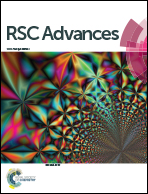Single-component and competitive adsorption of tetracycline and Zn(ii) on an NH4Cl-induced magnetic ultra-fine buckwheat peel powder biochar from water: studies on the kinetics, isotherms, and mechanism†
Abstract
Single-component and competitive adsorption of tetracycline (TC) and Zn(II) on an NH4Cl-induced magnetic ultra-fine buckwheat peel powder biochar (NH4Cl-BHP-char/Fe3O4) was investigated in batch experiments. NH4Cl-BHP-char/Fe3O4 exhibited a large surface area of 1119.097 m2 g−1 and a total pore volume of 0.139 cm3 g−1 and was easily separated from aqueous solution using a magnet. Also, adsorption was endothermic, spontaneous, and highly pH-dependent. The optimum pH of the single-component adsorption of TC and Zn(II) was 4.0 and 6.5, respectively, and the optimum pH of co-adsorption was 6.0. The kinetics studies showed the prepared biochar could be rapidly adsorbed within 60 min, and chemical adsorption was dominant. For single-component adsorption, the maximum adsorption capacities of TC and Zn(II) were 106.38 and 151.52 mg g−1, respectively, and they underwent monolayer adsorption on the biochar surface. Moreover, for competitive adsorption, maximum TC and Zn(II) adsorption capacities of 126.58 and 357.14 mg g−1 were achieved. Both film diffusion and intra-particle diffusion were found to be significant processes to facilitate adsorption. TC and Zn(II) promoted the adsorption of each other. The proposed biochar could be used repeatedly for at least four cycles. All these results demonstrated that developed NH4Cl-BHP-char/Fe3O4 was regarded as a low-cost alternative adsorbent to remove the heavy metal ions and antibiotic pollutants from water or wastewater.



 Please wait while we load your content...
Please wait while we load your content...